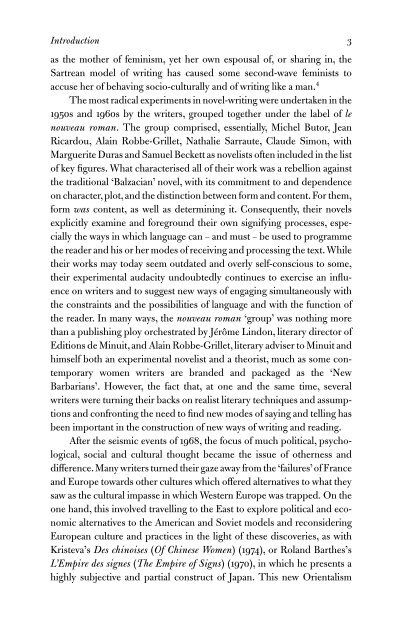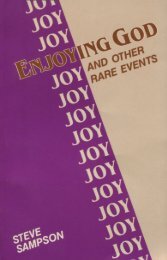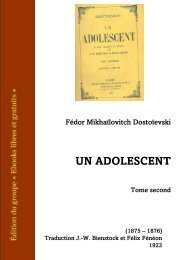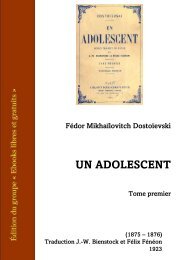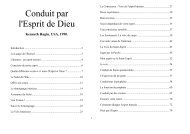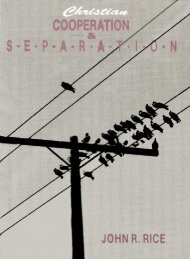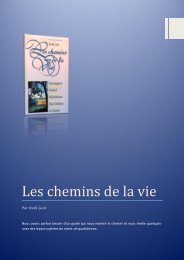Women writing in contemporary France
Create successful ePaper yourself
Turn your PDF publications into a flip-book with our unique Google optimized e-Paper software.
Introduction 3<br />
as the mother of fem<strong>in</strong>ism, yet her own espousal of, or shar<strong>in</strong>g <strong>in</strong>, the<br />
Sartrean model of <strong>writ<strong>in</strong>g</strong> has caused some second-wave fem<strong>in</strong>ists to<br />
accuse her of behav<strong>in</strong>g socio-culturally and of <strong>writ<strong>in</strong>g</strong> like a man. 4<br />
The most radical experiments <strong>in</strong> novel-<strong>writ<strong>in</strong>g</strong> were undertaken <strong>in</strong> the<br />
1950s and 1960s by the writers, grouped together under the label of le<br />
nouveau roman. The group comprised, essentially, Michel Butor, Jean<br />
Ricardou, Ala<strong>in</strong> Robbe-Grillet, Nathalie Sarraute, Claude Simon, with<br />
Marguerite Duras and Samuel Beckett as novelists often <strong>in</strong>cluded <strong>in</strong> the list<br />
of key figures. What characterised all of their work was a rebellion aga<strong>in</strong>st<br />
the traditional ‘Balzacian’ novel, with its commitment to and dependence<br />
on character, plot, and the dist<strong>in</strong>ction between form and content. For them,<br />
form was content, as well as determ<strong>in</strong><strong>in</strong>g it. Consequently, their novels<br />
explicitly exam<strong>in</strong>e and foreground their own signify<strong>in</strong>g processes, especially<br />
the ways <strong>in</strong> which language can – and must – be used to programme<br />
the reader and his or her modes of receiv<strong>in</strong>g and process<strong>in</strong>g the text. While<br />
their works may today seem outdated and overly self-conscious to some,<br />
their experimental audacity undoubtedly cont<strong>in</strong>ues to exercise an <strong>in</strong>fluence<br />
on writers and to suggest new ways of engag<strong>in</strong>g simultaneously with<br />
the constra<strong>in</strong>ts and the possibilities of language and with the function of<br />
the reader. In many ways, the nouveau roman ‘group’ was noth<strong>in</strong>g more<br />
than a publish<strong>in</strong>g ploy orchestrated by Jérôme L<strong>in</strong>don, literary director of<br />
Editions de M<strong>in</strong>uit, and Ala<strong>in</strong> Robbe-Grillet, literary adviser to M<strong>in</strong>uit and<br />
himself both an experimental novelist and a theorist, much as some <strong>contemporary</strong><br />
women writers are branded and packaged as the ‘New<br />
Barbarians’. However, the fact that, at one and the same time, several<br />
writers were turn<strong>in</strong>g their backs on realist literary techniques and assumptions<br />
and confront<strong>in</strong>g the need to f<strong>in</strong>d new modes of say<strong>in</strong>g and tell<strong>in</strong>g has<br />
been important <strong>in</strong> the construction of new ways of <strong>writ<strong>in</strong>g</strong> and read<strong>in</strong>g.<br />
After the seismic events of 1968, the focus of much political, psychological,<br />
social and cultural thought became the issue of otherness and<br />
difference. Many writers turned their gaze away from the ‘failures’ of <strong>France</strong><br />
and Europe towards other cultures which offered alternatives to what they<br />
saw as the cultural impasse <strong>in</strong> which Western Europe was trapped. On the<br />
one hand, this <strong>in</strong>volved travell<strong>in</strong>g to the East to explore political and economic<br />
alternatives to the American and Soviet models and reconsider<strong>in</strong>g<br />
European culture and practices <strong>in</strong> the light of these discoveries, as with<br />
Kristeva’s Des ch<strong>in</strong>oises (Of Ch<strong>in</strong>ese <strong>Women</strong>) (1974), or Roland Barthes’s<br />
L’Empire des signes (The Empire of Signs) (1970), <strong>in</strong> which he presents a<br />
highly subjective and partial construct of Japan. This new Orientalism


